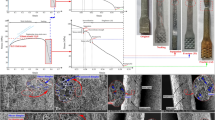Abstract
To effectively improve the interfacial bonding strength of a Cu/Al-layered composite strip prepared by a short process forming method of solid‒liquid cast-rolling, a novel process of vibration cast-rolling composite was proposed in this study. To verify the effectiveness of the novel technology in improving the bonding strength and deeply analyse the mechanism of this effect, pilot-scale vibration cast-rolling equipment was built. A thermal mechanical coupling numerical simulation model with the same size was established. Experiments and simulations showed that this method can effectively control the bonding strength by affecting the thickness of the interface layer. The control mechanism uses reciprocating cross shear behaviour caused by the roll vibration to cause ‘dynamic impact’ and ‘repeated rolling’ on the interface layer in the process of plastic deformation. This results in the crushing and thinning of the brittle phase at the interface to improve the interface bonding strength.










Similar content being viewed by others
Availability of data and materials
The video data of the cast-rolling mill is displayed in date in brief. Other information can be obtained by contacting the corresponding author at 2020509029@hust.edu.cn.
Code availability
Not applicable.
References
Singh J, Chauhan A (2016) Characterization of hybrid Al matrix composites for advan-ced applications-a review. J Mater Res Technol 5:159–169. https://doi.org/10.1016/j.jmrt.2015.05.004
Mai TA, Spowage AC (2004) Characterisation of dissimilar joints in laser welding of steel-kovar, Cu-steel and Cu-aluminium. Mater Sci Eng A 374:224–233. https://doi.org/10.1016/j.msea.2004.02.025
Me A, Gl A, Cl B, Qw A, Hj A, Wd A (2020) Experimental and numerical analysis of Cu/Al8011/Al1060 trilayered composite: a comprehensive study - sciencedirect. J Market Res 9(6):14695–14707
Dubourg L, Pelletier H, Vaissiere D, Hlawka F, Cornet A (2002) Mechanical characterisation of laser surface alloyed aluminium-Cu systems. Wear 253:1077–1085. https://doi.org/10.1016/S0043-1648(02)00218-1
Tao W, Wl A, Ylab C, Zwab C, Avi D, Qhab C (2021) Formation mechanism of dynamic multi-neutral points and cross shear zones in corrugated rolling of cu/al laminated composite. J Mater Process Technol 295
Manesh HD, Taheri AK (2003) Bond strength and formability of an Al-Clad steel sheet. J Alloys Compd 361:138–143. https://doi.org/10.1016/S0925-8388(03)00392-X
Grydin O, Gerstein G, Nuernberger F, Schaper M, Danchenko V (2013) Twin-roll cas-ting of Al-steel clad strips. J Manuf Process 15:501–507. https://doi.org/10.1016/j.jmapro.2013.08.008
Chen Y, Wang A, Tian H, Xie J, Wang X (2020) Study on optimization of nozzle for Cu-aluminium clad strip twin-roll cast-rolling. J Mater Res Technol 10. https://doi.org/10.1016/j.jmrt.2020.12.088
Wang A, Chen Y, Tian H, Xie J, Wang W (2019) Numerical simulation of cast-rolling process for copper-aluminum composite strip. Procedia Manuf 37:105–110. https://doi.org/10.1016/j.promfg.2019.12.021
Huang HG, Chen P, Ji C (2017) SLCR bonding (SLCRB) and annealing of Ti/Al c-ladding strip. Mater Des 118:233–244. https://doi.org/10.1016/j.matdes.2017.01.042
Li LX, Wang YH, Sun MH, Du FS (2020) First principles study on interface optimization mechanism of Cu-Al composite strip by vibration cast-rolling technology. Compos Interf. https://doi.org/10.1080/09276440.2020.1869890
Chen C, Chen H, Hwang W (2006) Influence of interfacial structure development o-n the fracture mechanism and bond strength of Al/Cu Bimetal strip. Mater Trans 47:1232–1239. https://doi.org/10.2320/matertrans.47.1232
Sheng LY, Yang F, Xi TF, Lai C, Ye HQ (2011) Influence of heat treatment on interface of Cu/Al bimetal composite fabricated by cold rolling. Compos B 42:1468–1473. https://doi.org/10.1016/j.compositesb.2011.04.045
Gao HT, Liu XH, Qi JL, Ai ZR, Liu LZ (2018) Microstructure and mechanicalproperties of Cu/Al/Cu clad strip processed by the powder-in-tube method. J Mater Process Technol 251:1–11. https://doi.org/10.1016/j.jmatprotec.2017.07.035
Kim WN, Sun IH (2016) Interactive deformation and enhanced ductility of tri-layered Cu/Al/Cu clad composite - ScienceDirect. Mater Sci Eng A 651:976–986. https://doi.org/10.1016/j.msea.2015.11.062
Park HJ, Kim IK, Hong SI (2016) Effect of interface structure on the stressstrain responses and fracture behaviors in tri-layered CU/AL/CU clad composite
Li LX, Sun MH, Fan MC, Yang TS, Du FS (2019) New rapid prototyping technology for the prevention of hydrogen embrittlement of metal strips. Corros Sci 164:108341. https://doi.org/10.1016/j.corsci.2019.108341
Ying L, Wei X, Yang Q, Zeng JW, Zhu W, Sunkulp G (2018) Constitutive beha-vior and processing map of T2 pure Cu deformed from 293 to 1073 K. J Mater Eng Perform 11:1–13. https://doi.org/10.1007/s11665-018-3210-4
Hust JG (1985) Thermophysical properties of some key solids, Ch. 5, thermal co-nductivity of Al, Cu, Fe and W. CODATA Bull 59
Sun J, Hui D, Di T (2009) Development survey and its application prospect of asy-nchronous rolling technology. Angang Technol. https://doi.org/10.1115/1.802922.paper82
Funding
This work was supported by the National Natural Science Foundation of China (51975510), National Science Foundation for Young Scientists of China (52105336).
Author information
Authors and Affiliations
Contributions
Minghan Sun and Lingxiao Li designed the study. Minghan Sun, Lingxiao Li and Qiuyue Du performed most experiments in this work and collected important background information. M.H. Sun completed most numerical simulation calculations. Xiaotao Liu and Chao Zhao provided assistance for data acquisition and data analysis. Lingxiao Li and Qiuyue Du drafted the manuscript. Minghan Sun and Lingxiao Li funded the research. All the authors reviewed the manuscript.
Corresponding author
Ethics declarations
Ethics approval
Not applicable.
Consent to participate
All the authors participated in the study.
Consent for publication
All the authors consent to publish.
Competing interests
The authors declare no competing interests.
Additional information
Publisher's Note
Springer Nature remains neutral with regard to jurisdictional claims in published maps and institutional affiliations.
Rights and permissions
Springer Nature or its licensor holds exclusive rights to this article under a publishing agreement with the author(s) or other rightsholder(s); author self-archiving of the accepted manuscript version of this article is solely governed by the terms of such publishing agreement and applicable law.
About this article
Cite this article
Li, L., Du, Q., Sun, M. et al. Study on the mechanism of strengthening the bonding strength of Cu/Al composite strip by cross shear behaviour from vibration cast-rolling process. Int J Adv Manuf Technol 121, 7413–7426 (2022). https://doi.org/10.1007/s00170-022-09851-4
Received:
Accepted:
Published:
Issue Date:
DOI: https://doi.org/10.1007/s00170-022-09851-4



